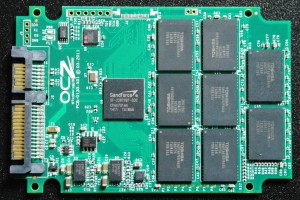INTERIOR COMPONENTS
The makeup of the Vertex 3 Max IOPS differs from the Vertex 3 in the placement of its Toshiba TH58TAG7D2FBAS9 memory chips and we have included pictures of both the MaxIOPS and Vertex 3 to demonstrate.
VERTEX 3 MAX IOPS

 The Max IOPS contains 16 modules of 16GB Toshiba 32nm NAND flash that was first seen in the Vertex 3 Pro reviews earlier this year.
The Max IOPS contains 16 modules of 16GB Toshiba 32nm NAND flash that was first seen in the Vertex 3 Pro reviews earlier this year.
This brings the total capacity of the drive to 256GB to which one module (16GB) is utilized for over provisioning (7%) and firmware which brings the total user capacity before formatting to 240GB. Don’t hold your breath just yet because formatting then leaves the user with a 223GB total available user capacity. Both the Vertex 3 and V3 Max IOPS version use the SandForce SF-2281 processor.
This is The SSD Review Test Bench and a quick click on the photo will bring it up full size for closer inspection.
- Our main goal in testing is to ensure that all test results are as accurate as they can be and no anomalies slip through. We conduct all tests three times and, if necessary, we may conduct specific tests in Windows 7 ‘safe mode’ to ensure the OS has little to no influence on the end result.
- We prefer to use as many benchmark programs as possible to assist with confirmation of results and provide the reader with the actual tests as received to avoid any confusion when unexpected test benchmarks are received.
BENCH CONFIGURATION
MOTHERBOARD: Gigabyte P67A-UD7 ATX LGA 1155 Intel SATA 6Gb/s USB 3.0
CPU: Intel Core i7-2600K Sandy Bridge 3.4GHz (3.8GHz Turbo Boost) 4 x 256KB L2 Cache 8MB L3 Cache LGA 1155 95W Quad-Core Desktop Processor
RAM: Corsair Vengeance 8GB DDR3 1600 SDRAM
GPU: MSI N560GTX-Ti Twin Frozr II OC Edition 1024MB GDDR5 PCI Express 2.0
POWER: Corsair Professional Series AX850 850W ATX12V v2.31 / EPS12V v2.92 80 PLUS GOLD Certified Modular Active PFC Power Supply
CHASSIS: Fractal-Design Define XL ATX Mid Tower Silent Computer Case
CPU COOLER: Corsair H50 High Performance Water CPU Cooler
NETWORK: DiLink Powerline AV Network With D-Link DIR 655 Wifi N Router
DVD: Sony Black 24X DVD+R 8X DVD+RW 8X DVD+R DL 24X DVD-R 6X DVD-RW 12X DVD-RAM 16X DVD-ROM 48X CD-R 32X CD-RW 48X CD-ROM 2MB Cache SATA 24X DVD Writer
STORAGE: 3 x Icy Dock 4×1 SSD Racks for 5.25″ Device Bay
BENCHMARK SOFTWARE
Software used for testing by The SSD Review consists of Crystal DiskMark, HDTune Pro, ATTO Benchmark, AS SSD, along with FutureMark PCMark Vantage.
The first four do a great job of showing us the numbers that we want to see, or dont want to see in some cases, while PCMark Vantage x64 is an excellent program which recreates tests that mimic the average users activity, all the while providing a medium to measure each.
SSD COMPRESSION AND TESTING FLUCTUATIONS
All SSDs are not created equal and many new SSD enthusiasts realize that when they test their new drive to confirm specifications and ensure all is in order. SandForce controlled SSDs, as in the OCZ Vertex 3 and vertex 3 Max IOPS, use compression techniques in storage whereas many others do not. This creates a bit of confusion when enthusiasts test the drive with random data through benchmarking programs such as AS SSD and Crystal Diskmark. The results seem to be lower than the listed specifications.
The results actually present a false portrayal of the drives ability when compared to other drives such as Samsung, Crucial or Intel. It is for this reason that all of our comparison testing is done through PCMark Vantage. PCMark Vantage HDD Suite simply provides evaluation results based on transfer speeds reached through typical user patterns. Vantage provides a better testing medium, in that, it sees through the typical synthetic benchmarks and provides us with ‘true to life’ results of the drive.
As you will see shortly, SandForce has already established consistent top benchmark results and the Vertex 3 Max IOPS steps up even beyond the Vertex 3 goes well beyond that.
Pg1 – Introduction
Pg2 – Interior Components & Test Protocol
Pg3 – Initial Testing
Pg4 – AS SSD Performance
Pg5 – HDTune Benchmarks
Pg6 – PCMark Vantage Comparisons
Pg7 – Conclusions
 The SSD Review The Worlds Dedicated SSD Education and Review Resource |
The SSD Review The Worlds Dedicated SSD Education and Review Resource | 
